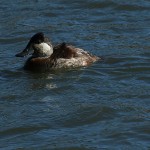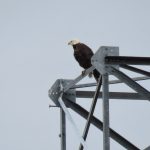One great thing about being a wildlife enthusiast in North Texas is that the mix of species that can be found here gets reshuffled several times a year with the changing of the seasons. That’s especially true of waterfowl, many of which are in Texas only during the colder months of the year. Nowhere is this phenomenon more evident than in our local wetlands. Our Lakes, ponds, and marshes attract an amazing variety of waterfowl species—especially in the wintertime.
Many species of birds congregate in our wetlands. A grand assortment of ducks, geese, coots, grebes, gulls, and herons gather in Dallas/Fort Worth each winter. When these wonderful winter waterfowl take up residence in our local duck ponds where they can be come quite tolerant of the presence of people. That can make them fantastic subjects for those looking to take their first forays into the pursuit of wildlife photography.
Let’s take a quick look at a sampling of some of the more common—and uncommon—wintertime waterfowl found in the DFW metroplex…
Ruddy Duck

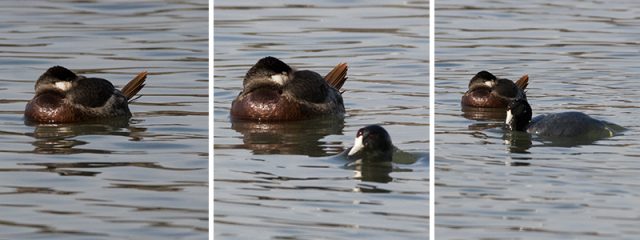
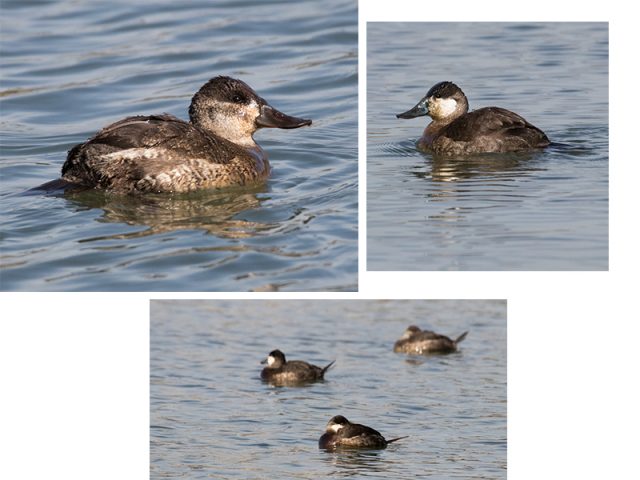
Wikipedia describes the Ruddy Duck in this way:
These are small, compact ducks with stout, scoop-shaped bills, and long, stiff tails they often hold cocked upward. They have slightly peaked heads and fairly short, thick necks. Male Ruddy Ducks have blackish caps that contrast with bright white cheeks. In summer, they have rich chestnut bodies with bright blue bills. In winter, they are dull gray-brown above and paler below with dull gray bills. Females and first-year males are brownish, somewhat like winter males but with a blurry stripe across the pale cheek patch. In flight, Ruddy Ducks show solidly dark tops of the wings.
Their breeding habitat is marshy lakes and ponds. They nest in dense marsh vegetation near water. The female builds the nest out of grass, locating it in tall vegetation to hide it from predators. A typical brood contains 5 to 15 ducklings. Pairs form each year.
They are migratory and winter in coastal bays and unfrozen lakes and ponds.
These birds dive and swim underwater. They mainly eat seeds and roots of aquatic plants, aquatic insects and crustaceans.
American Wigeon
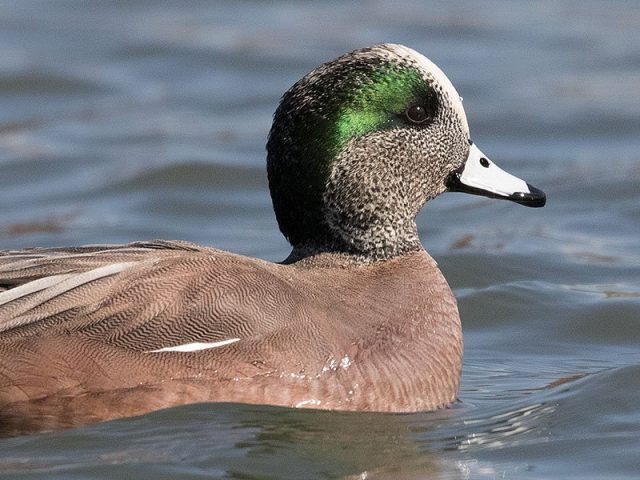
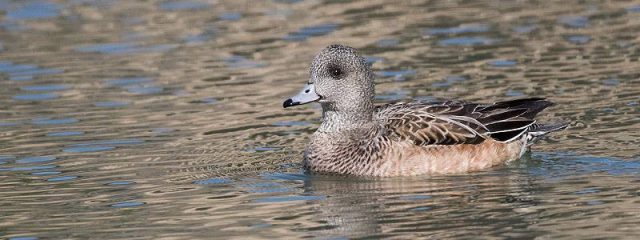
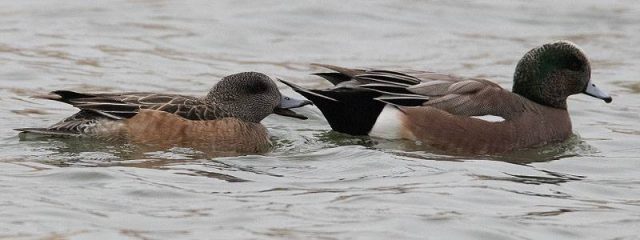
Wikipedia relates this information about the American Wigeon:
The American wigeon is a medium-sized bird; it is larger than a teal, but smaller than a pintail. In silhouette, the wigeon can be distinguished from other dabblers by its round head, short neck, and small bill. It is 42–59 cm (17–23 in) long, with a 76–91 cm (30–36 in) wingspan and a weight of 512–1,330 g (1.129–2.932 lb). This wigeon has two adult molts per year and a juvenile molt in the first year, as well.
The breeding male (drake) is a striking bird with a mask of green feathers around its eyes and a cream colored cap running from the crown of its head to its bill. This white patch gives the wigeon its other common name, baldpate (pate is another word for head). Their belly is also white. In flight, drakes can be identified by the large white shoulder patch on each wing. These white patches flash as the birds bank and turn. In non-breeding (eclipse) plumage, the drake looks more like the female.
The hens are much less conspicuous, having primarily gray and brown plumage. Both sexes have a pale blue bill with a black tip, a white belly, and gray legs and feet. The wing patch behind the speculum is gray. They can be distinguished from most ducks, apart from Eurasian wigeon, by shape. However, that species has a darker head and all grey underwing. The head and neck coloring of the female is different as opposed to the Eurasian wigeon. It nests on the ground, near water and under cover. It lays 6–12 creamy white eggs. Flocks will often contain American coots.
The American wigeon is a noisy species, and in the field can often be identified by their distinctive calls. Drakes produce a three note whistle, while hens emit hoarse grunts and quacks. The male whistle makes a wheezy whoee-whoe-whoe, whereas the female has a low growl qua-ack.
American Coot


American Coots are described by Wikipedia in this way:
The American coot (Fulica americana), also known as a mud hen, is a bird of the family Rallidae. Though commonly mistaken to be ducks, American coots belong to a distinct order. Unlike the webbed feet of ducks, coots have broad, lobed scales on their lower legs and toes that fold back with each step in order to facilitate walking on dry land. Coots live near water, typically inhabiting wetlands and open water bodies in North America. Groups of coots are called covers or rafts. The oldest known coot lived to be 22 years old.
The American coot is a migratory bird that occupies most of North America. It lives in the Pacific and southwestern United States and Mexico year-round and occupies more northeastern regions during the summer breeding season. In the winter they can be found as far south as Panama. Coots generally build floating nests and lay 8–12 eggs per clutch. Females and males have similar appearances, but they can be distinguished during aggressive displays by the larger ruff (head plumage) on the male. American coots eat primarily algae and other aquatic plants but also animals (both vertebrates and invertebrates) when available.
The American coot is listed as “Least Concern” under the IUCN conservation ratings. Hunters generally avoid killing American coots because their meat is not as sought after as that of ducks.
Much research has been done on the breeding habits of American coots. Studies have found that mothers will preferentially feed offspring with the brightest plume feathers, a characteristic known as chick ornaments. American coots are also susceptible to conspecific brood parasitism and have evolved mechanisms to identify which offspring are theirs and which are from parasitic females.
Bufflehead


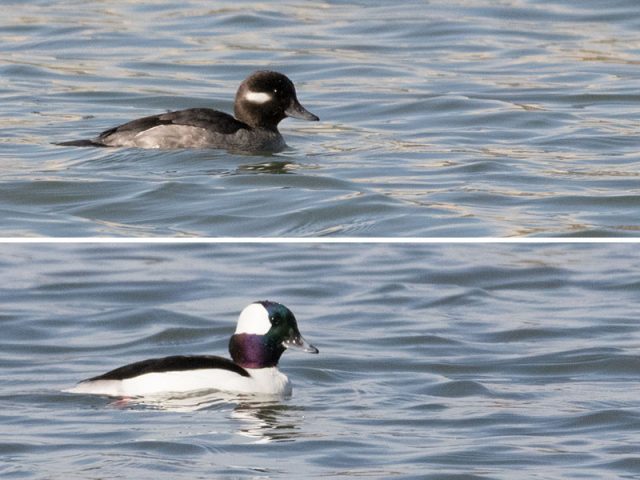
Buffleheads are described by Wikipedia in this fashion:
Buffleheads have evolved their small size to fit the nesting cavity of their “metabiotic” host, a woodpecker, the northern flicker. Due to their small size, they are highly active, undertaking dives almost continuously while sustained by their high metabolism. They do not tend to collect in large flocks; groups are usually limited to small numbers. One duck serves as a sentry, watching for predators as the others in the group dive in search of food. Buffleheads are amongst the last waterfowl to leave their breeding grounds and one of the world’s most punctual migrants, arriving on their wintering grounds within a narrow margin of time.
Buffleheads are monogamous, and the females return to the same breeding site, year after year. They nest in cavities in trees, primarily aspens or poplars, using mostly old flicker nests, close (usually < 25 m (82 ft)) to water. Nest competitors include mountain bluebird (Sialia currucoides), tree swallow (Tachycineta bicolor), and European starling. There was one recorded instance of a female Barrow's goldeneye killing a bufflehead adult female and her brood. Smaller cavities are preferred because of less competition with the larger goldeneyes. Females may be killed on the nest by mammals, such as weasels (Mustela spp.) or mink (Mustela vison), and by goldeneyes over nest competition. Average clutch size is nine (range six to 11), and eggs average 50.5 by 36.3 mm (1.99 by 1.43 in). Incubation averages 30 days, and nest success is high (79% in one study) compared to ground-nesting species like the teal. A day after the last duckling hatches, the brood leaps from the nest cavity. The young fledge at 50–55 days of age. Predators of adults include the peregrine falcon (Falco peregrinus), snowy owl (Bubo scandiacus), bald eagle (Haliaeetus leucocephalus), golden eagle (Aquila chrysaetos), red-tailed hawk (Buteo jamaicensis), great horned owl (Bubo virginianus), Eurasian eagle owl (Bubo bubo), and Cooper's hawk (Accipiter cooperii).
Gadwall
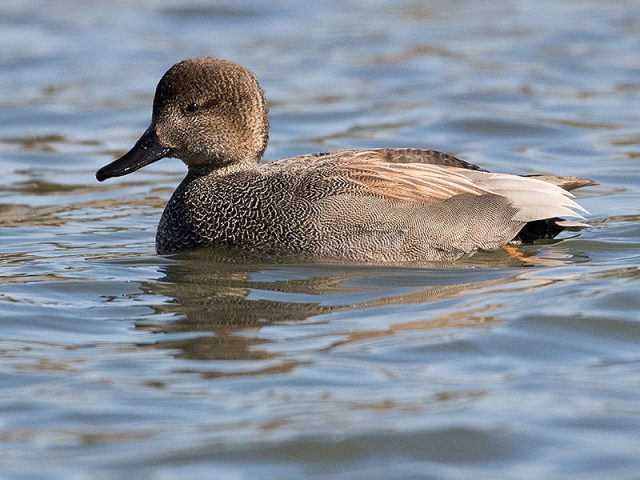
Wikipedia describes Gadwalls in this way:
The gadwall is 46–56 cm (18–22 in) long with a 78–90 cm (31–35 in) wingspan. The male is slightly larger than the female, weighing on average 990 g (35 oz) against her 850 g (30 oz). The breeding male is patterned grey, with a black rear end, light chestnut wings, and a brilliant white speculum, obvious in flight or at rest. In non-breeding (eclipse) plumage, the drake looks more like the female, but retains the male wing pattern, and is usually greyer above and has less orange on the bill.
The female is light brown, with plumage much like a female mallard. It can be distinguished from that species by the dark orange-edged bill, smaller size, the white speculum, and white belly. Both sexes go through two moults annually, following a juvenile moult.
The gadwall is a quieter duck, except during its courtship display. Females give a call similar to the quack of a female mallard but higher-pitched, transcribed as gag-ag-ag-ag. Males give a grunt, transcribed as nheck, and a whistle.
The gadwall is a bird of open wetlands, such as prairie or steppe lakes, wet grassland or marshes with dense fringing vegetation, and usually feeds by dabbling for plant food with head submerged. It nests on the ground, often some distance from water. It is not as gregarious as some dabbling ducks outside the breeding season and tends to form only small flocks. This is a fairly quiet species; the male has a hoarse whistling call, and the female has a mallard-like quack. The young birds are fed insects at first; adults also eat some molluscs and insects during the nesting season.
Horned Grebe


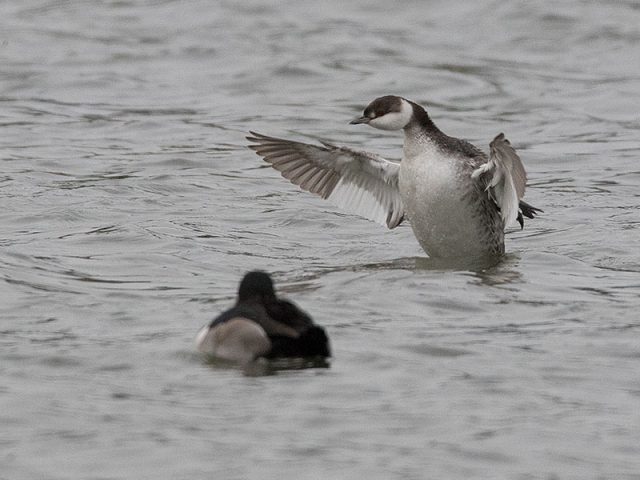
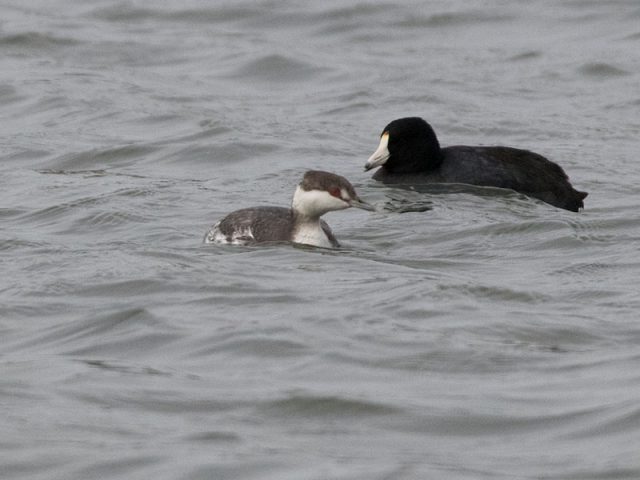
Wikipedia has this to say about the Horned Grebe:
Birders can easily recognize the Horned Grebe by its red-and-black alternate (breeding) plumage, its black-and-white basic (non-breeding) plumage and its characteristic “horns”. This small grebe is 31–38 cm long, has a wingspan 55–74 cm wide and weighs 300-570 g. It has a moderately long neck, flat forehead and a rear crown of black feathers. Its beak is straight and pointy with a white tip. Both subspecies are physically similar except, P.a. auritius (Eurasia) appears darker than P.a.cornutus (North America), which has light grey feathers on its back inconspicuous or absent in P.a.auritius. The Horned Grebe is often confused with the Eared Grebe, which is similar in size and colouring but differentiates by a steeper forehead, a more slender bill and a fluffier rump.
The alternate (breeding) plumage of the Horned Grebe has bright erectable “horns”, black fan-shaped cheek feathers and an overall red-and-black colour. The neck, flanks, lores and upper-chest are chestnut brown, while the crown and back are black. The belly is a dull white. Males are slightly larger and brighter than females but are generally indistinguishable.
The basic (non-breeding) plumage is overall black and white. The neck, chest and cheeks are white, while the back and crown are a dull black-grey. The border between the crown and the cheeks extend in a straight line behind the eyes. The basic plumage does not have “horns”.
Juveniles appear similar to a non-breeding adult except they are a slightly duller shade of white and their back is tinged with brown. The line separating the cheeks and crown is less distinct and their beak is paler. The chicks are fluffy, with a dull grey back, a white belly and interesting black-and-white facial stripping.
Northern Shoveler
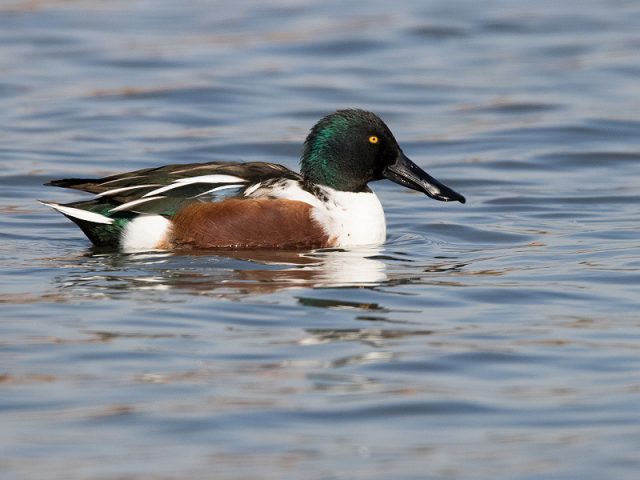
The Northern Shoveler has these characteristics according to Wikipedia:
This species is unmistakable in the northern hemisphere due to its large spatulate bill. The breeding drake has an iridescent dark green head, white breast and chestnut belly and flanks. In flight, pale blue forewing feathers are revealed, separated from the green speculum by a white border. In early fall the male will have a white crescent on each side of the face. In non-breeding (eclipse) plumage, the drake resembles the female.
The female is a drab mottled brown like other dabblers, with plumage much like a female mallard, but easily distinguished by the long broad bill, which is gray tinged with orange on cutting edge and lower mandible. The female’s forewing is gray.
Northern shovelers feed by dabbling for plant food, often by swinging its bill from side to side and using the bill to strain food from the water. They use their highly specialized bill (from which their name is derived) to forage for aquatic invertebrates – a carnivorous diet. Their wide-flat bill is equipped with well-developed lamellae – small, comb-like structures on the edge of the bill that act like sieves, allowing the birds to skim crustaceans and plankton from the water’s surface. This adaptation, more specialized in shovelers, gives them an advantage over other puddle ducks, with which they do not have to compete for food resources during most of the year. Thus, mud-bottomed marshes rich in invertebrate life are their habitat of choices.
Large groups of northern shovelers swim rapidly in circles to collect food from the surface by creating a funnel effect.
The shoveler prefers to nest in grassy areas away from open water. Their nest is a shallow depression on the ground, lined with plant material and down. Hens typically lay about nine eggs. The drakes are very territorial during breeding season and will defend their territory and partners from competing males. Drakes also engage in elaborate courtship behaviors, both on the water and in the air; it is not uncommon for a dozen or more males to pursue a single hen. Despite their stout appearance, shovelers are nimble fliers.
This is a fairly quiet species. The male has a clunking call, whereas the female has a Mallard-like quack.
Lesser Scaup

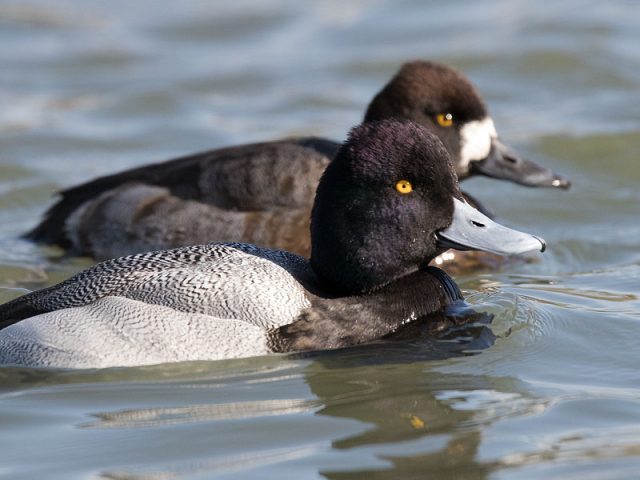
From Wikipedia’s article on Lesser Scaup:
The adult males (drakes) in alternate plumage have a black, iridescent head and a small tuft at the hindcrown, a black breast, a whitish-grey back and wings with darker vermiculations and black outer and greyish-brown inner primary remiges. The underparts are white with some olive vermiculations on the flanks, and the rectrices and tail coverts are black. Adult females (hens) have a white band at the base of the bill, often a lighter ear region, and are otherwise dark brown all over, shading to white on the mid-belly. Drakes in eclipse plumage look similar, but with a very dark head and breast, little or no white on the head and usually some greyish vermiculations on the wings. Immature birds resemble the adult females, but are duller and have hardly any white at the bill base. Both sexes have white secondary remiges, a blue-grey bill with a black “nail” at the tip and grey feet; the drakes have a bright yellow iris, while that of females is orange or amber and that of immatures is brown. Downy hatchlings look much like those of related species, with dark brown upperparts and pale buff underparts, chin, supercilium and back spots.
These birds are not very vocal, at least compared to dabbling ducks. Hens give the namesake discordant scaup, scaup call; in courtship drakes produce weak whistles. Hens vocalize more often than those of the greater scaup—particularly during flight—but their call is weaker, a guttural brrtt, brrtt.
Hooded Merganser


Wikipedia describes the Common Merganser in this way:
The hooded merganser (Lophodytes cucullatus) is a species of small duck. It is the only extant species in the genus Lophodytes. The bird is striking in appearance; both sexes have crests that they can raise or lower, and the breeding plumage of the male is handsomely patterned and coloured. The hooded merganser has a sawbill but is not classified as a typical merganser.
Hooded mergansers are the second smallest species of merganser, with only the smew of Europe and Asia being smaller, and it also is the only merganser whose native habitat is restricted to North America.
A species of fossil duck from the Late Pleistocene of Vero Beach, Florida, was described as Querquedula floridana (a genus now included in Anas), but upon reexamination turned out to be a species closely related to the hooded merganser; it is now named Lophodytes floridanus, but the exact relationship between this bird and the modern species is unknown.
The hooded merganser is a diving predator that largely hunts by sight while under water. Most studies report that its diet varies according to circumstances, usually being dominated by fishes (44-81%). In addition it feeds on aquatic insects (13-20% of its diet) and other aquatic invertebrates such as crabs and crayfish (22-50%).
Great Egret
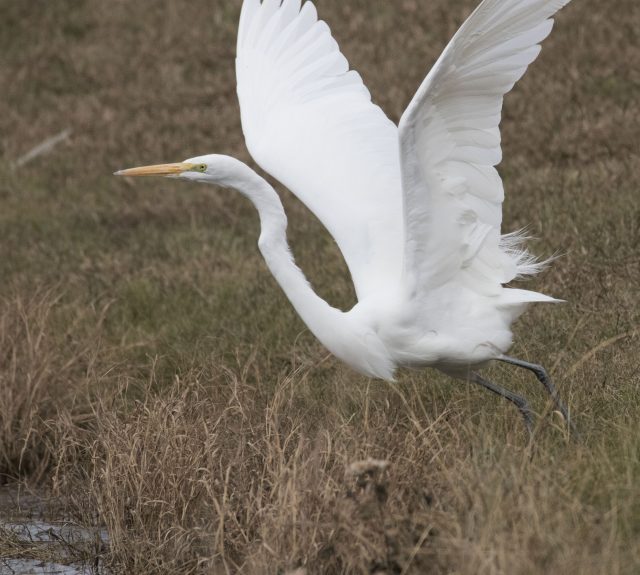

Wikipedia describes the Great Egret in this way:
The great egret (Ardea alba), also known as the common egret, large egret or (in the Old World) great white heron, is a large, widely distributed egret, with four subspecies found in Asia, Africa, the Americas, and southern Europe. Distributed across most of the tropical and warmer temperate regions of the world. It builds tree nests in colonies close to water.
Like all egrets, it is a member of the heron family, Ardeidae. Traditionally classified with the storks in the Ciconiiformes, the Ardeidae are closer relatives of pelicans and belong in the Pelecaniformes instead. The great egret—unlike the typical egrets—does not belong to the genus Egretta but together with the great herons is today placed in Ardea. In the past, however, it was sometimes placed in Egretta or separated in a monotypic genus Casmerodius.
The Old World population is often referred to as the great white egret. This species is sometimes confused with the great white heron of the Caribbean, which is a white morph of the closely related great blue heron.
The great egret is a large heron with all-white plumage. Standing up to 1 m (3.3 ft) tall, this species can measure 80 to 104 cm (31 to 41 in) in length and have a wingspan of 131 to 170 cm (52 to 67 in). Body mass can range from 700 to 1,500 g (1.5 to 3.3 lb), with an average of around 1,000 g (2.2 lb). It is thus only slightly smaller than the great blue or grey heron (A. cinerea). Apart from size, the great egret can be distinguished from other white egrets by its yellow bill and black legs and feet, though the bill may become darker and the lower legs lighter in the breeding season. In breeding plumage, delicate ornamental feathers are borne on the back. Males and females are identical in appearance; juveniles look like non-breeding adults. Differentiated from the intermediate egret (Mesophoyx intermedius) by the gape, which extends well beyond the back of the eye in case of the great egret, but ends just behind the eye in case of the intermediate egret.
It has a slow flight, with its neck retracted. This is characteristic of herons and bitterns, and distinguishes them from storks, cranes, ibises, and spoonbills, which extend their necks in flight. The great egret walks with its neck extended and wings held close. The great egret is not normally a vocal bird; it gives a low hoarse croak when disturbed, and at breeding colonies, it often gives a loud croaking cuk cuk cuk and higher-pitched squawks.
Ring-billed Gull
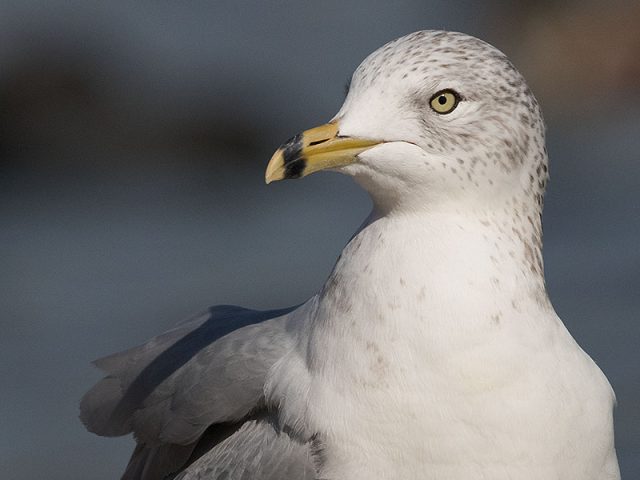

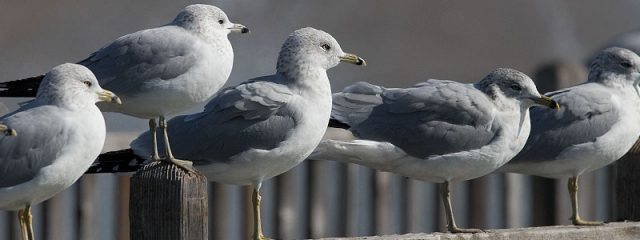
According to Wikipedia, Ring-billed Gull have these behaviors and characteristics:
The ring-billed gulls’ breeding habitat is near lakes, rivers, or the coast in Canada and the northern United States. They nest colonially on the ground, often on islands. This bird tends to be faithful to its nesting site, if not its mate, from year to year.
The ring-billed gull is a familiar sight in the shopping mall parking lots of the United States, where it can regularly be found congregating in large numbers. In some areas, it is displacing less aggressive birds such as the common tern.
They are migratory and most move south to the Gulf of Mexico and the Atlantic and Pacific coasts of North America, also the Great Lakes.
This gull is a regular wanderer to western Europe. In Ireland and Great Britain it is no longer classed as a rarity, with several birds regularly wintering in these countries.
Ring-billed gulls forage in flight or pick up objects while swimming, walking or wading. They also steal food from other birds and frequently scavenge. They are omnivorous; their diet may include insects, fish, grain, eggs, earthworms and rodents. These birds are opportunistic and have adapted well to taking food discarded or even left unattended by people. It is regarded as a pest by many beach-goers because of its willingness to steal unguarded food on highly crowded beaches. The gull’s natural enemies are rats, foxes, dogs, cats, raccoons, coyotes, eagles, hawks, and owls.
Common Goldeneye
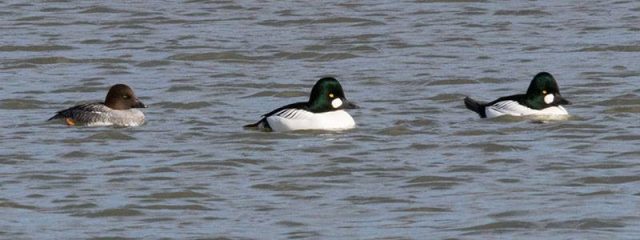
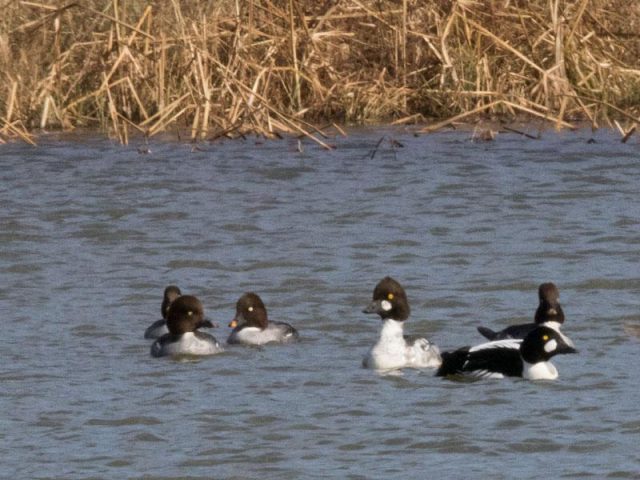
Wikipedia has this to say about the Common Goldeneye:
The common goldeneye (Bucephala clangula) is a medium-sized sea duck of the genus Bucephala, the goldeneyes. Its closest relative is the similar Barrow’s goldeneye. The genus name is derived from Ancient Greek boukephalos, “bullheaded”, from bous, “bull ” and kephale, “head”, a reference to the bulbous head shape of the bufflehead. The species name is derived from Latin clangere, “to resound”.
Their breeding habitat is the taiga. They are found in the lakes and rivers of boreal forests across Canada and the northern United States, Scandinavia and northern Russia. They are migratory and most winter in protected coastal waters or open inland waters at more temperate latitudes. Naturally, they nest in cavities in large trees. They will readily use nestboxes, and this has enabled a healthy breeding population to establish in Scotland where they are increasing and slowly spreading with the help of nestboxes. They are usually quite common in winter around lakes of Britain and some are being encouraged to nest in nestboxes which are put up to try to have them there all year round. Occasionally recorded as a vagrant in various parts of the Indian Subcontinent.
Often the natural tree cavities are made by broken limbs, unless they are made by pileated woodpeckers or black woodpeckers, the only tree-cavity-making animals who make a cavity large enough to normally accommodate a goldeneye. Average egg size is a breadth of 43.3 mm (1.70 in), a length of 59.3 mm (2.33 in) and a weight of 64 g (2.3 oz). The incubation period ranges from 28 to 32 days. The female does all the incubating and is abandoned by
the male about 1 to 2 weeks into incubation. The young remain in the nest for about 24–36 hours. Brood parasitism is quite common both with other common goldeneyes as well as with other duck species, and even tree swallow and European starling eggs have been found mixed with goldeneye eggs. The broods commonly start to mix with other females’ broods as they become more independent. Goldeneye young have been known to be competitively killed by other goldeneye mothers, common loons and red-necked grebes. The young are capable of flight at 55–65 days of age.
These diving birds forage underwater. Year-round, about 32% of their prey is crustaceans, 28% is aquatic insects and 10% is molluscs. Insects are the predominant prey while nesting and crustaceans are the predominant prey during migration and winter. Locally, fish eggs and aquatic plants can be important foods. They themselves may fall prey to various hawks, owls and eagles, while females and their broods have been preyed upon by bears (Ursus spp.), various weasels (Mustela spp.), mink (Mustela vison), raccoons (Procyon lotor) and even northern flickers (Colaptes auratus) and red squirrels (Tamiasciurus husonicus).
Mallard
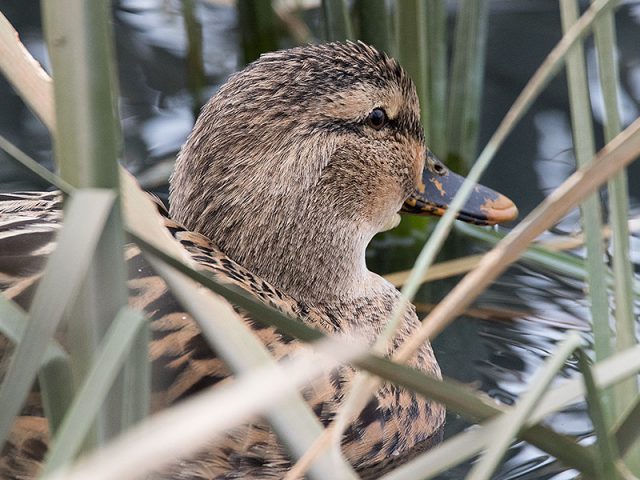
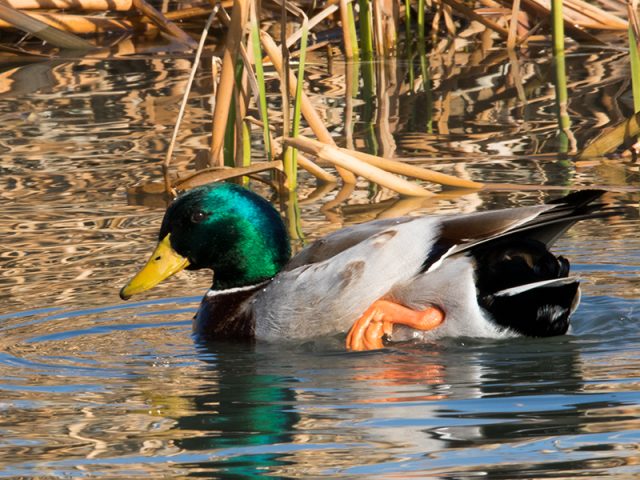
Wikipedia describes the Mallard in this way:
The mallard or wild duck (Anas platyrhynchos) is a dabbling duck which breeds throughout the temperate and subtropical Americas, Eurasia, and North Africa, and has been introduced to New Zealand, Australia, Peru, Brazil, Uruguay, Argentina, Chile, the Falkland Islands and South Africa. This duck belongs to the subfamily Anatinae of the waterfowl family Anatidae.
The male birds (drakes) have a glossy green head and are grey on wings and belly, while the females (hens or ducks) have mainly brown-speckled plumage. Both sexes have an area of white-bordered black speculum feathers which commonly also include iridescent blue feathers especially among males. Mallards live in wetlands, eat water plants and small animals, and are social animals preferring to congregate in groups or flocks of varying sizes. This species is the main ancestor of most breeds of domesticated ducks.
The mallard is widely distributed across the Northern and Southern Hemispheres; in North America from southern and central Alaska to Mexico, the Hawaiian Islands, across Eurasia, from Iceland and southern Greenland and parts of Morocco (North Africa) in the west, Scandinavia to the north, and to Siberia, Japan, and South Korea, in the east, Australia and New Zealand in the Southern hemisphere. It is strongly migratory in the northern parts of its breeding range, and winters farther south. For example, in North America, it winters south to Mexico, but also regularly strays into Central America and the Caribbean between September and May.
The mallard inhabits a wide range of habitat and climates, from Arctic tundra to subtropical regions. It is found in both fresh- and salt-water wetlands, including parks, small ponds, rivers, lakes and estuaries, as well as shallow inlets and open sea within sight of the coastline. Water depths of less than 1 metre (3.3 ft) are preferred, birds avoiding areas more than a few metres deep. They are attracted to bodies of water with aquatic vegetation.
Ring-necked Duck

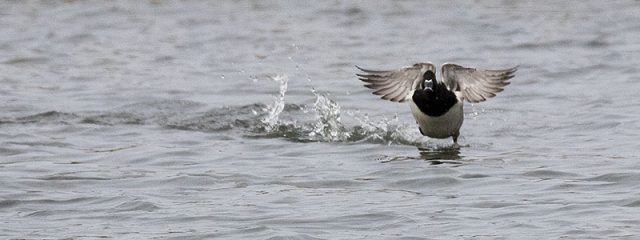
Ring-necked Ducks are described in this way by Wikipedia:
Ring-necked ducks are small to medium-sized diving ducks. The adult male is similar in color pattern to the Eurasian tufted duck, its relative. Males are a little bit bigger than the female. It has two white rings surrounding its gray bill, a shiny black angular head, black back, white line on the wings, a white breast and yellow eyes. The adult female has a grayish brown angular head and body with a dark brown back, a dark bill with a more subtle light band than the male, grayish-blue feet and brown eyes with white rings surrounding them. Females also make a noise like trrr. The cinnamon neck ring is usually difficult to observe, which is why the bird is sometimes referred to as a “ringbill”.
Their breeding habitat is wooded lakes or ponds in the northern United States and Canada. The main breeding area is Northwest boreal forest territories. Their breeding habits also take place in the eastern boreal region of Canada but no where near the same amount in the northwestern region. Winter months they are usually found in southern North America in lakes, ponds, rivers or bays. Ring-necked duck pairs start during spring migration. Unpaired ducks showing up on breeding grounds will most likely end up being non-breeders. The pairs stay together only for reproduction, until then, they separate. The nest is bowl-shaped, built on water in dense emergent vegetation with sedges and woody plants. The female lays one egg per day until 8 to 10 eggs are laid. They are incubated 25–29 days and the female may remain with the young until they are able to fly.
These birds are omnivores and feed mainly by diving or dabbling at the surface. Ducklings are dependent on animal matter such as insects earth worms, leeches, midges and snails. As they mature they tend change their diet to submerged plants such as pondweed and coontail, and emergents such as annual wild rice and snails.
White-faced Ibis
This bird is a little different form the others. The White-faced Ibis has typically wintered along the coast, but recently it has begun expanding its winter range northward into the metroplex and beyond!
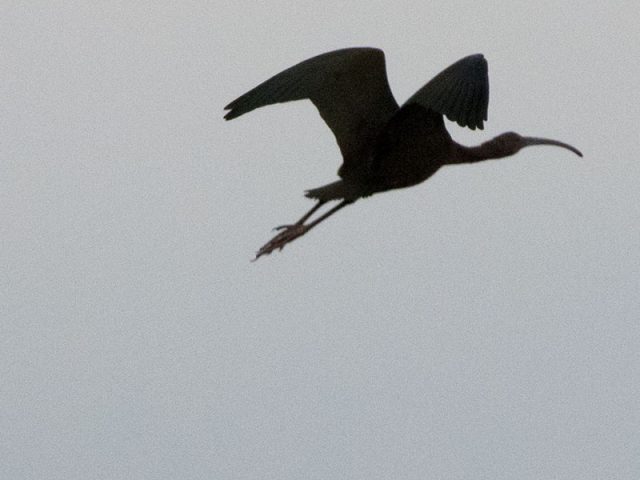


Wikipedia has this to say about the White-faced Ibis:
The white-faced ibis (Plegadis chihi) is a wading bird in the ibis family Threskiornithidae. This species breeds colonially in marshes, usually nesting in bushes or low trees. Its breeding range extends from the western United States south through Mexico, as well as from southeastern Brazil and southeastern Bolivia south to central Argentina, and along the coast of central Chile. Its winter range extends from southern California and Louisiana south to include the rest of its breeding range.
The white-faced ibis eats a variety of organisms, including many invertebrates such as insects, leeches, snails and earthworms. It may also eat vertebrates such as fish, crayfish, newts, and frogs. Its feeding style is to use its bill to probe for prey.
This species breeds colonially in marshes, usually nesting in bushes or low trees. Its breeding range extends from the western United States south through Mexico, as well as from southeastern Brazil and southeastern Bolivia south to central Argentina, and along the coast of central Chile. Its winter range extends from southern California and Louisiana south to include the rest of its breeding range. The white-faced ibis chooses to nest in the parts of a marsh with dense vegetation such as bulrush, cattails, shrubs and short trees. It will then build a nest from reeds. The white-faced ibis usually lays three or four blue-green eggs at a time.
Canada Goose

Wikipedia has this to say about the Canada Goose:
The Canada goose (Branta canadensis) is a large wild goose species with a black head and neck, white patches on the face, and a brown body. Native to arctic and temperate regions of North America, its migration occasionally reaches northern Europe. It has been introduced to the United Kingdom, New Zealand, Argentina, Chile, and the Falkland Islands. Like most geese, the Canada goose is primarily herbivorous and normally migratory; it tends to be found on or close to fresh water.
Extremely successful at living in human-altered areas, Canada geese have proven able to establish breeding colonies in urban and cultivated areas, which provide food and few natural predators, and are well known as a common park species. Their success has led to them often being considered a pest species because of their depredation of crops and issues with their noise, droppings, aggressive territorial behavior, and habit of begging for food, especially in their introduced range. Canada geese are also among the most commonly hunted waterfowl in North America.
Like most geese, the Canada goose is naturally migratory with the wintering range being most of the United States. The calls overhead from large groups of Canada geese flying in V-shaped formation signal the transitions into spring and autumn. In some areas, migration routes have changed due to changes in habitat and food sources. In mild climates from California to the Great Lakes, some of the population has become nonmigratory due to adequate winter food supply and a lack of former predators.
Males exhibit agonistic behaviour both on and off breeding and nesting grounds. This behavior rarely involves interspecific killing. One documented case involved a male defending his nest from a brant goose that wandered into the area; the following attack lasted for one hour until the death of the brant. The cause of death was suffocation or drowning in mud as a direct result of the Canada goose’s pecking the head of the brant into the mud. Researchers attributed it to high hormone levels and the brant’s inability to leave the nesting area.
Canada geese are primarily herbivores, although they sometimes eat small insects and fish. Their diet includes green vegetation and grains. The Canada goose eats a variety of grasses when on land. It feeds by grasping a blade of grass with the bill, then tearing it with a jerk of the head. The Canada goose also eats beans and grains such as wheat, rice, and corn when they are available. In the water, it feeds from silt at the bottom of the body of water. It also feeds on aquatic plants, such as seaweeds. In urban areas, it is also known to pick food out of garbage bins.
Northern Pintail
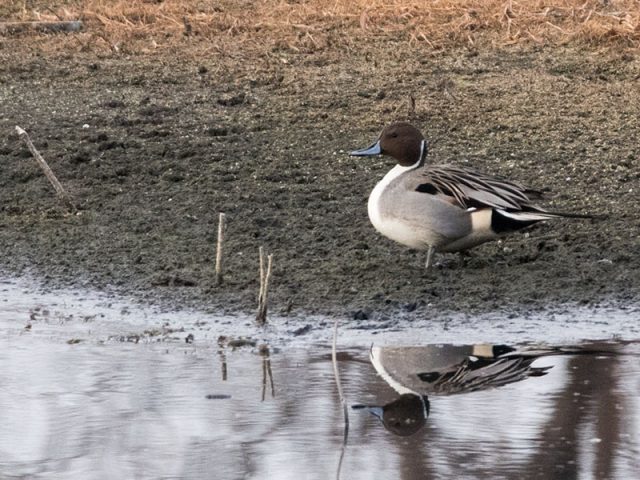


Wikipedia includes this information about the Northern Pintail:
The pintail or northern pintail (Anas acuta) is a duck with wide geographic distribution that breeds in the northern areas of Europe, Asia and North America. It is migratory and winters south of its breeding range to the equator. Unusually for a bird with such a large range, it has no geographical subspecies if the possibly conspecific duck Eaton’s pintail is considered to be a separate species.
This is a large duck, and the male’s long central tail feathers give rise to the species’ English and scientific names. Both sexes have blue-grey bills and grey legs and feet. The drake is more striking, having a thin white stripe running from the back of its chocolate-coloured head down its neck to its mostly white undercarriage. The drake also has attractive grey, brown, and black patterning on its back and sides. The hen’s plumage is more subtle and subdued, with drab brown feathers similar to those of other female dabbling ducks. Hens make a coarse quack and the drakes a flute-like whistle.
The northern pintail is a bird of open wetlands which nests on the ground, often some distance from water. It feeds by dabbling for plant food and adds small invertebrates to its diet during the nesting season. It is highly gregarious when not breeding, forming large mixed flocks with other species of duck. This duck’s population is affected by predators, parasites and avian diseases. Human activities, such as agriculture, hunting and fishing, have also had a significant impact on numbers. Nevertheless, owed to the huge range and large population of this species, it is not threatened globally.
Canvasback


Canvasbacks are described by Wikipedia in this way:
The canvasback has a distinctive wedge-shaped head and long graceful neck. The adult male (drake) has a black bill, a chestnut red head and neck, a black breast, a grayish back, black rump, and a blackish brown tail. The drake’s sides, back, and belly are white with fine vermiculation resembling the weave of a canvas, which gave rise to the bird’s common name. The bill is blackish and the legs and feet are bluish-gray. The iris is bright red in the spring, but duller in the winter. The adult female (hen) also has a black bill, a light brown head and neck, grading into a darker brown chest and foreback. The sides, flanks, and back are grayish brown. The bill is blackish and the legs and feet are bluish-gray. Its sloping profile distinguishes it from other ducks.
The breeding habitat of the canvasback is in North America prairie potholes. The bulky nest is built from vegetation in a marsh and lined with down. Loss of nesting habitat has caused populations to decline. The canvasback usually takes a new mate each year, pairing in late winter on ocean bays. It prefers to nest over water on permanent prairie marshes surrounded by emergent vegetation, such as cattails and bulrushes, which provide protective cover. Other important breeding areas are the subarctic river deltas in Saskatchewan and the interior of Alaska.
It has a clutch size of approximately 5–11 eggs, which are greenish drab. The chicks are covered in down at hatching and able to leave the nest soon after. The canvasback sometimes lays its eggs in other canvasback nests and redheads often parasitize canvasback nests.




